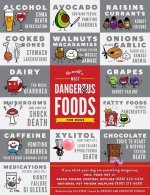- May 2, 2013
- 13,698
- 2,178
- Country
- U.S.A.
- Bulldog(s) Names
- Maudee,MarthaKatie,Lizzie,Bro.Mini
Your six-month-old puppy, Hoover, will eat anything that isn’t tied down. Like many dog owners, you know chocolate can be dangerous to your pooch. But you may not know that if Hoover sticks his nose in your handbag and eats a pack of sugarless chewing gum, the consequences could be deadly.
Sugarless gum may contain xylitol, a class of sweetener known as sugar alcohol. Xylitol is present in many products and foods for human use, but can have devastating effects on your pet.
Over the past several years, the Center for Veterinary Medicine at the U.S. Food and Drug Administration (FDA) has received several reports—many of which pertained to chewing gum—of dogs being poisoned by xylitol, according to Martine Hartogensis, a veterinarian at FDA.
And you may have seen recent news stories about dogs that have died or become very ill after eating products containing xylitol.
back to top
[h=4]Other Foods Containing Xylitol[/h] But gum isn’t the only product containing xylitol. Slightly lower in calories than sugar, this sugar substitute is also often used to sweeten sugar-free candy, such as mints and chocolate bars. Other products that may contain xylitol include:
[h=4]Why is Xylitol Dangerous to Dogs, but Not People?[/h] In both people and dogs, the level of blood sugar is controlled by the release of insulin from the pancreas. In people, xylitol does not stimulate the release of insulin from the pancreas. However, it’s different in canines: When dogs eat something containing xylitol, the xylitol is more quickly absorbed into the bloodstream, and may result in a potent release of insulin from the pancreas.
This rapid release of insulin may result in a rapid and profound decrease in the level of blood sugar (hypoglycemia), an effect that can occur within 10 to 60 minutes of eating the xylitol. Untreated, this hypoglycemia can quickly be life-threatening, Hartogensis says.
back to top
[h=4]Symptoms to Look For in Your Dog[/h] Symptoms of xylitol poisoning in dogs include vomiting, followed by symptoms associated with the sudden lowering of your dog’s blood sugar, such as decreased activity, weakness, staggering, incoordination, collapse and seizures.
If you think your dog has eaten xylitol, take him to your vet or an emergency animal hospital immediately, Hartogensis advises. Because hypoglycemia and other serious adverse effects may not occur in some cases for up to 12 to 24 hours, your dog may need to be monitored.
(A note to cat owners: The toxicity of xylitol for cats has not been documented. They appear to be spared, at least in part, by their disdain for sweets.)
Sugarless gum may contain xylitol, a class of sweetener known as sugar alcohol. Xylitol is present in many products and foods for human use, but can have devastating effects on your pet.
Over the past several years, the Center for Veterinary Medicine at the U.S. Food and Drug Administration (FDA) has received several reports—many of which pertained to chewing gum—of dogs being poisoned by xylitol, according to Martine Hartogensis, a veterinarian at FDA.
And you may have seen recent news stories about dogs that have died or become very ill after eating products containing xylitol.
back to top
[h=4]Other Foods Containing Xylitol[/h] But gum isn’t the only product containing xylitol. Slightly lower in calories than sugar, this sugar substitute is also often used to sweeten sugar-free candy, such as mints and chocolate bars. Other products that may contain xylitol include:
- breath mints
- baked goods
- cough syrup
- children’s and adult chewable vitamins
- mouthwash
- toothpaste
[h=4]Why is Xylitol Dangerous to Dogs, but Not People?[/h] In both people and dogs, the level of blood sugar is controlled by the release of insulin from the pancreas. In people, xylitol does not stimulate the release of insulin from the pancreas. However, it’s different in canines: When dogs eat something containing xylitol, the xylitol is more quickly absorbed into the bloodstream, and may result in a potent release of insulin from the pancreas.
This rapid release of insulin may result in a rapid and profound decrease in the level of blood sugar (hypoglycemia), an effect that can occur within 10 to 60 minutes of eating the xylitol. Untreated, this hypoglycemia can quickly be life-threatening, Hartogensis says.
back to top
[h=4]Symptoms to Look For in Your Dog[/h] Symptoms of xylitol poisoning in dogs include vomiting, followed by symptoms associated with the sudden lowering of your dog’s blood sugar, such as decreased activity, weakness, staggering, incoordination, collapse and seizures.
If you think your dog has eaten xylitol, take him to your vet or an emergency animal hospital immediately, Hartogensis advises. Because hypoglycemia and other serious adverse effects may not occur in some cases for up to 12 to 24 hours, your dog may need to be monitored.
(A note to cat owners: The toxicity of xylitol for cats has not been documented. They appear to be spared, at least in part, by their disdain for sweets.)









